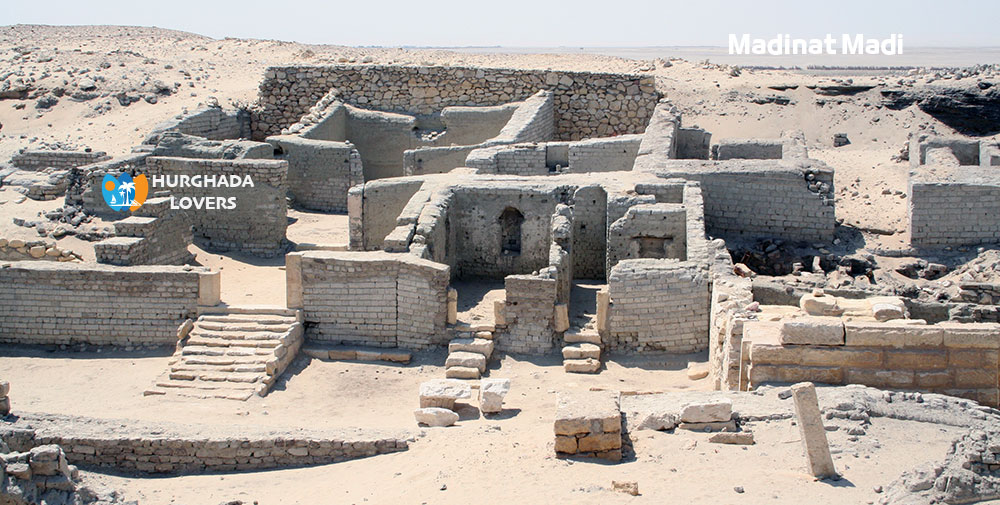Madinat Madi in Fayoum, Egypt | Facts, History, Map Madinat Madi in Faiyum, Greco-Roman period and more about Narmouthis.
Facts and history of the most important pharaonic archaeological areas in southern Egypt and the relics and secrets they contain of the kings of the pharaohs in the ancient civilization of Egypt and more.
Madinat Madi is an archaeological area that testifies to the greatness of Pharaonic history, although not many people know about it. This great city is located in the center of Atsa in the Fayoum Governorate.
It is considered the oldest archaeological area in the governorate and the most isolated, and here lies the secret of its attractiveness. It was called in the Pharaonic era the city of Jia and in the era of the Ptolemaic rule the city of Narmothes.
Hurghada lovers Offer Luxury Hurghada to Pyramids Tours | El Gouna to Pyramids Tours | Makadi bay to Pyramids Tours | Sahl Hasheesh to Pyramids Tours | Soma bay to Pyramids Tours .
Madinat Madi
When was Madi City built?
● The city of Madi was built during the reign of the Twelfth Dynasty, about 4000 years ago, between 1794-1985 BC.
● The city is divided into a western part that was built during the reign of King Amenemhat III and an eastern part that was built during the reign of King Amenemhat IV.
● The city contains many temples, but the main temple was dedicated to the worship of the crocodile, which was called Sobek, and the worship of the cobra snake, which was called Rannott. This temple, despite its simple design, is considered the largest and oldest temple that was built during the era of the Middle Kingdom in ancient Egypt.
What is the history of Madinat Madi?
● The city of Madi was not called by this name by chance, as this city bears witness to a rich past throughout the ages.
● After the end of the Middle Kingdom, the population abandoned Madi and turned to agricultural reclamation elsewhere in Egypt. The temples there lost their importance over the years and were covered with sand.
● During the era of the Ptolemaic rule of Egypt in the fourth and first centuries AD, the city of Madi was reconstructed, where the temple was restored, expanded, surrounded by a long wall, and considered this city a holy city. Which explains what was discovered by archaeologists about the presence of inscriptions in the Greek language in the city of Madi.
● During the era of Roman rule, during the reign of Emperor Diocletian in the fifth century AD, the Narmothys camp was built at the eastern edge of the city, and this camp hosted the soldiers of the Fourth Kohos Battalion.
● In the Coptic era, the population settled heavily in this area and built many churches during the fifth, sixth and seventh centuries. About 10 churches dating from this era were discovered.
● After the Arab and Islamic conquest of Egypt, the population abandoned this area again until archaeologists and excavations discovered it again.
What is inside Madi City?
● The Great Temple of Madi: The entrance to the temple finds a pair of columns, each of which ends with two capitals that take the form of a papyrus bundle and reach the ceiling, which collapsed due to the factors of time. The facade of the temple is decorated with the Egyptian Corniche.
● The religious texts on the walls of the temple express the stages of the foundation rites. According to these rites, the temple is divided into two large halls, the Transfiguration Hall and the Offering Hall. Pictures of offerings to the god Sobek, the god Rennoutt and the god Isis appear on the walls.
● During the Roman period of the city, many statues with a human head and a lion’s body were carved.
● Bodies of creatures in different stages of growth were found, in addition to a cache of eggs. And it hurts that these corpses were used as offerings to the gods
● The temple contains a long road that resembles the path of rams. It was discovered by the mission of the Italian University of Pisa. It is 336 meters long and seven meters wide. This road includes 23 statues of lions, including 5 statues that express a female lion while breastfeeding her children. It is likely that this road was established as an altar for offerings to the gods.
● An ancient painting dating back to the era of Queen Cleopatra and King Ptolemy was found. It contains a gift from the port of Al-Kabash Road and his wife.
When was Madi city discovered?
● Commissioned by Napoleon Bonaparte during the period of the French campaign against Egypt, the Italian papyrologist and archaeologist Achille Foliano began studying the area.
● The entire temple of Madinat Madi was discovered in 1937 by an expedition from the University of Milan.
● Since the late seventies until now, the Italian University of Pisa has been sending restorers and archaeologists to carry out excavations and excavations and reach more archaeological discoveries in this region, in cooperation with Egyptian archaeologists.
● The city of Madi was recently given this name according to its name in the maps of Fayoum Governorate in the book Description of Egypt.
What is the price of a ticket to visit the city of Madi for the Egyptians?
● Madi city visit ticket fees for adults: 10 EGP
● As for the Madi city visit ticket fees for Egyptian students, it is: 5 Egyptian pounds
What is the price of a ticket to visit Madi for foreigners?
● The fee for a ticket to visit Madi is 50 Egyptian pounds
● In the event that the visitor is a foreign student, the entrance fee: 25 Egyptian pounds
